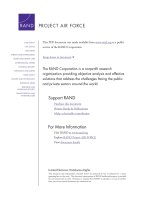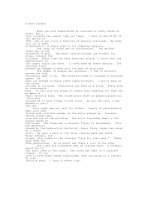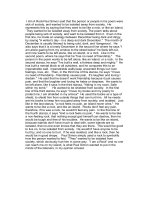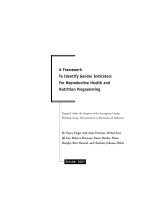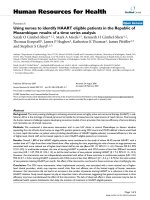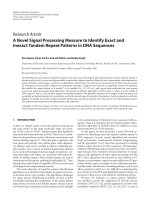Minerals rock identify a mineral
Bạn đang xem bản rút gọn của tài liệu. Xem và tải ngay bản đầy đủ của tài liệu tại đây (1.77 MB, 46 trang )
Minerals ROCK!
This presentation was made possible with funding from the
PromoScience programme of NSERC
©McGill University 2010
Minerals
Why are they important?
©McGill University 2010
Minerals are important because:
We use them in everyday life!
• Glass (Quartz)
www.public-domain-image.com
©McGill University 2010
Minerals are important because:
We use them in everyday life!
• Glass (Quartz)
• Lead in pencil (Graphite)
www.public-domain-image.com
©McGill University 2010
Minerals are important because:
We use them in everyday life!
• Glass (Quartz)
• Lead in pencil (Graphite)
• Toothpaste (Fluorite)
www.public-domain-image.com and www.wikipedia.org. Public domain.
©McGill University 2010
Minerals are important because:
We use them in everyday life!
•
•
•
•
Glass (Quartz)
Lead in pencil (Graphite)
Toothpaste (Fluorite)
Coins and wiring (Chalcopyrite, from which
most copper metal is made)
www.public-domain-image.com and www.wikipedia.org. Public domain.
©McGill University 2010
Minerals are important because:
We use them in everyday
life!
•
•
•
•
Glass (Quartz)
Lead in pencil (Graphite)
Toothpaste (Fluorite)
Coins and wiring
(Chalcopyrite, from which
most copper metal is made)
• White paint (Rutile and
Ilmenite)
www.public-domain-image.com and www.wikipedia.org. Public domain.
©McGill University 2010
Minerals are important because:
We use them in everyday life!
•
•
•
•
Glass (Quartz)
Lead in pencil (Graphite)
Toothpaste (Fluorite)
Coins and wiring (Chalcopyrite,
from which most copper metal
is made)
• White paint (Rutile and
Ilmenite)
• Make-up (Talc, Muscovite)
www.public-domain-image.com, www.wikipedia.org, and wpclipart.com.
Public domain.
©McGill University 2010
Minerals are important because:
We use them in everyday life!
•
•
•
•
Glass (Quartz)
Lead in pencil (Graphite)
Toothpaste (Fluorite)
Coins and wiring (Chalcopyrite, from which
most copper metal is made)
• White paint (Rutile and
Ilmenite)
• Makeup (Talc, Muscovite)
• Jewellery (Gold, Silver,
Platinum…)
www.public-domain-image.com, www.wikipedia.org, and wpclipart.com. Public domain.
©McGill University 2010
Minerals
• How many minerals are there in the world?
– Over 4200 different minerals!
– But only 100 are common
• Ones that are more rare include:
Gold
www.wikipedia.org. Public domain.
Silver
©McGill University 2010
What is a mineral?
• A mineral must have…
– A crystalline structure
– A definite chemical
composition
• A mineral must be…
– Formed by geological
processes
– Inorganic
– Solid
©McGill University 2010
What does this mean?
• A mineral must have….
– A crystalline structure
• Minerals are made of molecules, and a crystalline
structure is a repeated pattern of those molecules.
©McGill University 2010
Crystalline structure (i)
– The crystalline structure explains the geometric
shapes that crystals take on when they grow
under favourable conditions .
©McGill University 2010
Crystalline structure (ii)
• Crystals will keep growing…
©McGill University 2010
Crystalline structure (iii)
… and growing forever, as long as they have the
chemical elements and the environmental
conditions necessary.
©McGill University 2010
Minerals are formed by geological
processes
– They can’t be man-made so steel
is not a mineral.
www.wikipedia.org. Public domain.
©McGill University 2010
Minerals are inorganic
– Not living and not made by living things.
– Shells are not a type of mineral but they they are
made of solid materials (biominerals) similar to
some inorganic minerals.
Redpath Museum
©McGill University 2010
A mineral is solid
– Minerals may be dissolved in liquids but they
themselves are not liquid.
www.wikipedia.org
©McGill University 2010
Is ice a mineral? (i)
www.usgs.gov. Public domain.
©McGill University 2010
Is ice a mineral? (ii)
• YES!!
– Inorganic
– Solid
– Crystalline structure
– As long as it is naturally
occurring, ice is
considered a mineral.
Ice in your ice-cube tray
is not naturally occurring:
ice in a glacier is.
www.wikipedia.org. Creative Commons Attribution-Share Alike 3.0 Unported license
©McGill University 2010
Is water a mineral? (i)
www.usgs.gov. Public domain.
©McGill University 2010
Is water a mineral? (ii)
• NO!
– Inorganic
– Naturally occurring
– But it is a LIQUID and
has NO CRYSTALLINE
STRUCTURE
www.usgs.gov. Public domain.
©McGill University 2010
How are minerals formed?
• Many minerals crystallize from liquids,
principally magma/lava (molten rock), hot
waters (e.g., geysers), or oceans.
• Others are formed when rocks are re-buried
below the Earth’s surface and exposed to high
pressure and temperature. The minerals
become unstable and they exchange chemical
elements. This forms new minerals.
©McGill University 2010
Why are minerals found in large
quantities in some places and not
others?
• The Earth’s surface is made up of plates that
move. “Plate tectonics” describe this motion.
• Together with erosion, plate tectonics
concentrate some of these elements in
bodies of rocks that can be mined.
• Plate tectonics are the Earth's giant "recycling
engine“.
Plate tectonics
www.wikipedia.org. Public domain.
©McGill University 2010
